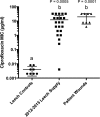Low-Level Antimicrobials in the Medicinal Leech Select for Resistant Pathogens That Spread to Patients
- PMID: 30042201
- PMCID: PMC6058295
- DOI: 10.1128/mBio.01328-18
Low-Level Antimicrobials in the Medicinal Leech Select for Resistant Pathogens That Spread to Patients
Abstract
Fluoroquinolones (FQs) and ciprofloxacin (Cp) are important antimicrobials that pollute the environment in trace amounts. Although Cp has been recommended as prophylaxis for patients undergoing leech therapy to prevent infections by the leech gut symbiont Aeromonas, a puzzling rise in Cp-resistant (Cpr) Aeromonas infections has been reported. We report on the effects of subtherapeutic FQ concentrations on bacteria in an environmental reservoir, the medicinal leech, and describe the presence of multiple antibiotic resistance mutations and a gain-of-function resistance gene. We link the rise of CprAeromonas isolates to exposure of the leech microbiota to very low levels of Cp (0.01 to 0.04 µg/ml), <1/100 of the clinical resistance breakpoint for Aeromonas Using competition experiments and comparative genomics of 37 strains, we determined the mechanisms of resistance in clinical and leech-derived Aeromonas isolates, traced their origin, and determined that the presence of merely 0.01 µg/ml Cp provides a strong competitive advantage for Cpr strains. Deep-sequencing the Cpr-conferring region of gyrA enabled tracing of the mutation-harboring Aeromonas population in archived gut samples, and an increase in the frequency of the Cpr-conferring mutation in 2011 coincides with the initial reports of CprAeromonas infections in patients receiving leech therapy.IMPORTANCE The role of subtherapeutic antimicrobial contamination in selecting for resistant strains has received increasing attention and is an important clinical matter. This study describes the relationship of resistant bacteria from the medicinal leech, Hirudo verbana, with patient infections following leech therapy. While our results highlight the need for alternative antibiotic therapies, the rise of Cpr bacteria demonstrates the importance of restricting the exposure of animals to antibiotics approved for veterinary use. The shift to a more resistant community and the dispersion of Cpr-conferring mechanisms via mobile elements occurred in a natural setting due to the presence of very low levels of fluoroquinolones, revealing the challenges of controlling the spread of antibiotic-resistant bacteria and highlighting the importance of a holistic approach in the management of antibiotic use.
Keywords: Aeromonas; antibiotic resistance; ciprofloxacin; genomics; leech therapy; microbiome.
Copyright © 2018 Beka et al.
Figures





References
-
- Jørgensen KM, Wassermann T, Jensen PØ, Hengzuang W, Molin S, Høiby N, Ciofu O. 2013. Sublethal ciprofloxacin treatment leads to rapid development of high-level ciprofloxacin resistance during long-term experimental evolution of Pseudomonas aeruginosa. Antimicrob Agents Chemother 57:4215–4221. doi:10.1128/AAC.00493-13. - DOI - PMC - PubMed
-
- Robinson TP, Bu DP, Carrique-Mas J, Fèvre EM, Gilbert M, Grace D, Hay SI, Jiwakanon J, Kakkar M, Kariuki S, Laxminarayan R, Lubroth J, Magnusson U, Thi Ngoc P, Van Boeckel TP, Woolhouse ME. 2016. Antibiotic resistance is the quintessential One Health issue. Trans R Soc Trop Med Hyg 110:377–380. doi:10.1093/trstmh/trw048. - DOI - PMC - PubMed
Publication types
MeSH terms
Substances
Grants and funding
LinkOut - more resources
Full Text Sources
Other Literature Sources
Miscellaneous
